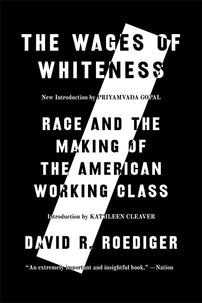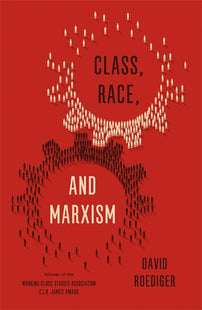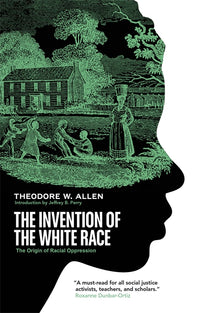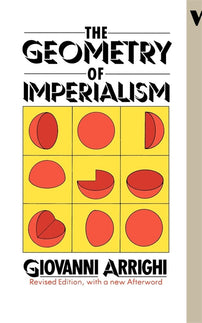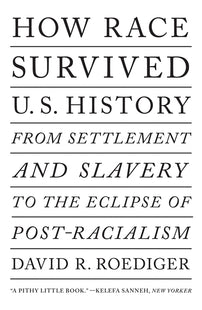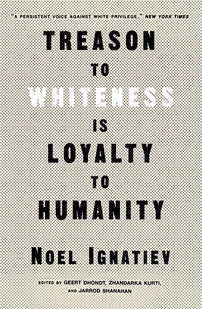Critical Studies of Whiteness: An Autobiographical Defence
Labor Historian David Roediger chronicles the formation of Critical Whiteness Studies through his own experience in the field.

The writing below excerpts and adapts a section of Verso author David Roediger’s An Ordinary White: My Anti-racist Education, an autobiography recently published by Fordham University Press.
I rose to a sort of pale academic fame in the 1990s following the publication of The Wages of Whiteness. The same book, plus sequels, also made me infamous, attracting right-wing and not-so-right-wing political attacks. Before that I was a labor historian, reliably providing quotes on efforts to gain a shorter working day in the US. Wages of Whiteness pretty much wrote itself as I tried to process the defeats of the left and labor. The result was a slight volume, not 200 pages of text, and thus perfect for the diminishing expectations of what undergraduates might read in a couple weeks of a course. It located the formation of a US working class alongside a much larger enslaved, racialized African American labor force and in the wake of a revolution. It has sold nearly 100,000 copies and approaches 10,000 citations, unheard of for a work of nineteenth-century US history. It is far from my best book, but is the one most a part of its historical moment.
It turned out that the idea of studying whiteness was in the air. A dozen serious books on the subject appeared in the nineties. By the end of the decade a group of individuals thinking through common problems had crystalized into what was termed a school of thought: Critical Whiteness Studies for those taking it seriously and Whiteness Studies for those snarking. Work on the critical study of whiteness varied in approaches and conclusions but took care to think about whiteness as a problem, as something created, embraced, and rejected in specific times and places and for identifiable purposes. Considering how many of us were on the left, we avoided magnifying disagreements into eviscerations. Especially within the fields of labor history and immigration history, the new scholarship challenged established narratives fundamentally. Such studies overlapped with what had come by 1989 to be termed Critical Race Theory (CRT), eventually a bête noire of the right.
It is hard to write about this period of my career without alarm. As I began writing autobiographically on the origins of the critical studies of whiteness the governor of Florida promoted attacks on both as his hoped-for ticket to the White House. To comply with his broad bans on the teaching of CRT in state schools biographies of such baseball superstars as Hank Aaron and Roberto Clemente disappeared from libraries amidst worries that the descriptions of racism in them could make schoolkids encouraged to identify as white feel badly about their patrimony. Florida’s campaign to prevent that goal now has a presidential seal of approval.
Parts of the left and liberalism proved almost as lacking in seriousness concerning the study of race as the right, taking potshots at the critical study of whiteness. It won’t do, in the face of hostility, to inflate the importance of such work. Blowing out of all proportion the influence of antiracist scholarship is in fact the tactic of those hostile to such work. Alarmists on the right imagine juggernauts bulldozing white self-esteem and taking society to the doorstep of making reparations for past injustices; left critics meanwhile conjure up a whiteness studies “industry” as what separates us from the left that we need. The hard truth supports neither accusation, especially where critical study of whiteness is concerned.
Differing emphases marked Critical Whiteness Studies from the start. One that proved popular was therapeutic, offering exercises designed to make healthier and more aware white individuals and communities. But the extent to which antiracist “trainings” have come to take place under corporate, military, and university diversity and equity bureaucracies almost ensured that they would not also emphasize larger points concerning race and capitalism. To the extent that we have sparked a dialogue capable of losing track of structures of class, empire, and even of systemic racism, we have failed. The problems created by this fact can’t be solved by magnifying their extent. It does not help to suppose that the diversity bureaucracy—itself being taken apart as I write—is an all-powerful professional-managerial class, somehow key to reproducing capitalist rule. Its practitioners, often well-meaning and sometimes products of left movements, are problematic enough as much smaller fries.
[book-strip index="1"]
But losing does not mean we were completely wrong, let alone faithless. The specific charges against those studying whiteness critically are plainly bullshit. We were not interested in homogenizing the experiences of so-called white people across lines of class or in blaming individuals. Most of us began by thinking urgently about the class differences among whites papered over by a belief in a common racial identity and interest. No writer I came to know in studying whiteness desired to make anybody feel bad for their race, which we regarded as an ideology and even, as per James Baldwin, as a lie.
The critical study of whiteness gained attention as the result of intellectuals and activists thinking about disasters in US electoral politics. In particular the consistent failure of the Democrats to capture the White House from 1968 through 1992, with Jimmy Carter’s single term being the forlorn exception, made for great attention to the defection of the “Reagan Democrats”—that is, the working class, often unionized white voters who had supported the New Deal tradition and rejected Republicans through the mid-1960s but who were won to Nixon, and then Reagan. They left the Democratic ranks partly on “social issues,” as racial justice and reproductive freedom came to be understood. They switched loyalty too over economic issues, like taxes, that were interlaced with race and welfare policies. Wooing of the Reagan Democrat became an obsession in the center-right of the Democratic Party, with eventual electoral success, but at great moral and policy costs, as discussed in my recent book, The Sinking Middle Class.
Within a decade after Reagan’s 1980 election the spate of books eventually grouped together as the critical study of whiteness began to appear. But essays came more quickly. By 1984, James Baldwin, as wonderful a nonfiction writer as he was a novelist, could write the most direct and clear short piece on the cost to everyone—decidedly including poor and immigrant whites—of what he called “choosing” to be white. He would place that seminal piece, “On Being White, and Other Lies,” in the African American popular beauty magazine Essence, suggesting a confidence that Reaganism had made possible an intelligible popular critique of whiteness. At about the same time, Baldwin would say, in the 1989 film The Price of the Ticket, to the dominant race in the US, “As long as you think you are white, there is no hope for you.”
I have resisted wanting to claim a role in the making of critical study of whiteness into either a media sensation or a distinct corner of academic research, even when someone I admire, like the historian and artist Nell Irvin Painter or the poet and critic Claudia Rankine, identifies me a founder of the enterprise. Indeed, I do not think that the critical study of whiteness ought to be a freestanding field apart from ethnic studies or Critical Race Theory. Perhaps this is because I came to study whiteness through Black Studies, broadly speaking. Not only do I oppose any aspiration to have a center or an academic major on the subject of whiteness, but I have never taught a class that focused on it. I know great people who have successfully taught such classes, but for me the risk of re-centering whiteness in such a setting remains too great.
I regarded as suspect claims that any small group of people—in press accounts often all-white—suddenly invented the study of white identities and interests in the early 1990s, when they first appeared. My reservations reflected how thoroughly such a scenario flew in the face of my own experiences in which almost every insight I developed regarding what African Americans had long insisted on calling the “white problem” came from reading their words from slave folktales and songs to the writings on whites of Harriet Jacobs, W.E.B. Du Bois, Ida B. Wells, Langston Hughes, Elma Stuckey, James Baldwin, Richard Wright, and others. Even in the 1990s the leading figures in studying whiteness decidedly included such Black, Latinx, and Indigenous authors as Toni Morrison, bell hooks, john powell, Cheryl Harris, Neil Foley, and Vine Deloria, Jr. The remarkable ability to miss all that was put on display when the New York Times Magazine devoted a lavish spread to an article called “Getting Credit for Being White” in 1997. The article, by Margaret Talbot, announced how out of touch with long traditions it was in its hook—first there was “porn studies” and now there’s “whiteness studies.” From there it was a short step to conclude that “whiteness studies” engaged “inevitably, in a journey of self-discovery in which white people’s thoughts about their own whiteness acquire a portentous new legitimacy.”
At almost the same time, a huge first-of-its-kind conference on the subject of whiteness convened at University of California at Berkeley. It brought together participants under the title “The Making and Unmaking of Whiteness,” produced excitement as most of us writing on the topic met for the first time. But it also generated a media buzz unheard of for a scholarly conference and did so based on a spectacular misapprehension. The mid-90s had produced a high tide of bipartisan white identity politics in which President William Jefferson Clinton joined Republicans in “ending welfare as we know it,” increasing incarceration, and making the death penalty more “effective.” The two major political parties vied for being the best listeners to the racial grievances of “middle class” whites. In such a context it became possible to completely misunderstand the Berkeley conference as an act of self-assertion by those labelling themselves and their interests as white. The day before the conference began a staffer from Nightline, the then-popular late-night national news show, called to ask if I’d appear. When it became clear that he anticipated onboarding a white intellectual wanting to sit at the table of identity politics, I pointed out that I and most of the conference presenters believed that concern for white interests already took up too much political and intellectual oxygen. We supported the “unmaking” of whiteness. “Oh,” the Nightline booker replied with admirable clarity and finality, “we wouldn’t be interested in that.”
[book-strip index="2"]
But when I looked for guidance on race and working-class conservatism in labor history, my field at the time, the pickings proved slim. There were some useful heroic accounts of Black-white unity in the US, less still on the exclusionary practices of unions and hate strikes, and next to nothing that addressed conservative white workers and their racial fears and commitments. That dearth sent me to look again at what I’d read in independent study classes with Sterling Stuckey in graduate school. Those courses, labeled as history classes but also distinctly interdisciplinary Black Studies ones, gave me the beginnings of a framework for discussing the “white problem.” When I argue that the study of whiteness grows out of ethnic studies, I am, at the very least, right that this describes my own experience.
For the enslaved and the Black radical tradition, the white problem involved practical questions of how to survive affronts and terror. The production of such knowledge, I soon realized, motivated the “John and the Master” folktales of the enslaved that had captivated me a decade before. African American folk stories, music, novels, poems, manifestoes, sociology, and history rendered the white problem as a moral, political, aesthetic, gendered, and even historical one, with great curiosity from slavery forward about just when and how some people came to define themselves as white. What defined modern critical studies of whiteness at their best was exactly this curiosity about how the white problem could be named and addressed. The debt of my best-known historical work on whiteness to the Black radical tradition caused me in 1998 to collect fifty representative pieces—including work by Adrian Piper, Langston Hughes, Derrick Bell, Toni Morrison, James Baldwin, Jacob Lawrence, Harriet Jacobs, Frederick Douglass, Richard Wright, bell hooks, W.E.B. Du Bois, and Sterling Brown—into the edited volume Black on White: Black Writers on What It Means to Be White. Those sampled were not only important interpreters of the Black experience but also as leading students of the white problem.
I remained more specifically interested in the “white worker problem” and the ways in which poor and laboring whites offered allegiance—not more than whites in other social locations but more tragically—to a system exploiting them. Here too the lessons I’d learned reading with Stuckey informed everything. My point of departure was the realization that whiteness presented problems for Black workers and for white workers wanting to act on class grievances. Chester Himes wrote of a Black character’s bad day in If He Hollers Let Him Go: “The white folks sure had brought their white to work that morning.” I left that line on my desk for a long time, puzzling over its meanings.
Du Bois wrote the passage that gave Wages of Whiteness its title. Of all the re-readings I did in the 1980s his Black Reconstruction was the most profound. Du Bois describes how white Southern laborers “received a low wage” after the Civil War. But additionally, they “were compensated in part by a sort of public and psychological wage … because they were white.” They accumulated “public deference and titles of courtesy” and accessed the best parks and schools. Law enforcement workers came from “their ranks” and courts sometimes kept them from prison. Also informing me was Du Bois’s unsparing clarity in stating that white labor did not just err here and get misled there but also itself stood against freedom at critical junctures during and after Reconstruction. While holding that “color caste [was] founded and retained by capitalism” he insisted that it came to be “adopted, forwarded and approved by white labor.”
As the 1990s proceeded and I met most writers on the critical history of whiteness, similarities impressed me more than the differences. Those of us writing on whiteness in the nineties represented a variety of political generations and commitments. But to an extent greater than any other area of historical inquiry, we were overwhelmingly on the left, often influenced by Marxism and steeped within either factory labor or labor support or both. It was in those realms that we learned to regard whiteness as a problem. That fact makes the charges that critical whiteness studies meant to change the subject from class to race, that we did not address intraracial class differences, and that we regarded the working class as hopelessly and particularly backwards hard to support. Underestimating the Marxism of the critical whiteness studies project made critics overestimate the role played by cultural studies, and even what was being called the “linguistic turn.” My work, for example, analyzed the usage of keywords like “boss,” “master,” and “white slave.” This proved enough to cause one labor historian attack it as mere “word play.” In fact, those keywords were the very languages of class, and the analytical framework derived from the British Marxism of Raymond Williams and the Russian Marxism of M.M. Bakhtin. I could make a case regarding the changing meanings of the terms “wage slavery” and “white slavery” before searching digitized newspapers was possible because of the generosity in sharing sources of the great US Marxist historian Herbert Shapiro.
Examples of how activism in working-class struggles shaped scholarship on whiteness multiplied as the nineties wore on. These included the best account of the labor process and whiteness, Bruce Nelson’s Divided We Stand: American Workers and the Struggle for Black Equality. Nelson had left post-graduate studies at Berkeley and San Francisco Theological Seminary to become a radical labor activist in the 1970s, working on a truck assembly line before pursuing a doctorate. Venus Green’s magnificent Race on the Line remains the most exciting study of how whiteness mattered where labor, gender, and skill were concerned in the telephone industry, where she had labored and organized long before completing her graduate work at Columbia. Before Karen Brodkin wrote How Jews Became White Folks and What that Says about Race in America she published a wonderful anthropological account of multiracial struggles of hospital workers, one she offered as a contribution to solidarity as well as to scholarship. Both Noel Ignatiev and Alexander Saxton—much more on them in the unabridged version of this story in An Ordinary White—were intellectuals making seminal contributions to critical whiteness studies and communist militants working many years in industrial jobs.
However defensive of the critical study of whiteness I became when it suffered attacks, my own early work in that area embarrasses me at times. My embarrassment begins with the subtitle of Wages of Whiteness. Even given publishers’ desires to oversell the breadth of content, Race and the Making of the American Working Class promises more than a short book can deliver and is wrong. The book is on the North and does not directly treat the enslaved and free Black working classes. Nor are women workers central, although my early writing connecting whiteness with manly independence attracted overly generous reviews where gender was concerned. I also do not use American when meaning US any longer. The “American Working Class” is then on many levels not the subject matter of the book.
More substantively, a mind-changing conference of the Australian Critical Race and Whiteness Studies Association in 2005 called certainties running through Wages of Whiteness much into question. In particular, the idea that the white worker’s identity formed against a Black other now seems to me only part of the story. I went to Brisbane to deliver a keynote at the invitation of Aileen Moreton-Robinson, the celebrated Aboriginal scholar who is part of the Goenpul people. Moreton-Robinson was developing a profound critique of the US literature on whiteness and brought me to Brisbane so that I would hear that critique. Her writings, her talks, the presentations of others at the conference, and above all the weight of white oppression in Australia made me question how it was that a white identity so familiar to me could develop in a place without African slavery, the touchstone of othering in my reckoning of US history. When I published How Race Survived US History in 2008, I began to register the extent to which whiteness in the US also formed around rejecting Indigenous claims, around acts of terror and dispossession, and around what Moreton-Robinson calls a “white possessive” occupation of land. Moreton-Robinson’s critique remains too little answered in both the critical study of whiteness generally and my own work. In that area and others,the critical study of whiteness is best conceived as a work in progress.
Excerpted from An Ordinary White: My Antiracist Education by David Roediger. Reprinted with permission from Fordham University Press. © Copyright 2025 by David Roediger.

